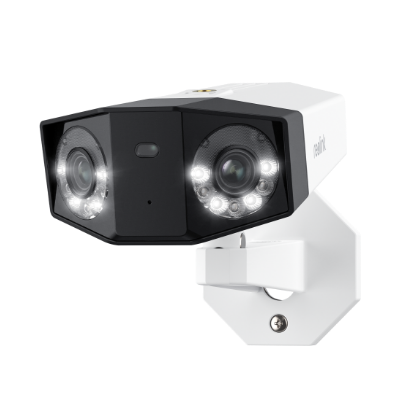Megapixels vs. Resolution: Are There Any Differences Between Them?

Megapixels and resolution are the two most confusing terms when you look for a camera, TV, or computer. However, these are the most important specifications to define image quality.
In this article, we will discuss megapixels vs. resolution. We will explain both and what they mean. We will share some important factors you need to consider while buying a camera.
Let's start with the basics.
What are Megapixels?
Megapixels means millions of pixels. It represents the total pixels a screen, camera, or anything else has in millions. It is a better way to explain the total number of pixels instead of looking at a large numerical value.
With that said, 1MP means one million pixels, 2MP means two million pixels, and so on.
But keep in mind that megapixels are often rounded off. For instance, the total number of pixels in Full HD is 2,073,600, so it is rounded off as 2MP (2 million pixels).
You will commonly see this specification on cameras, smartphones, TVs, laptops, etc.
What is Resolution?
Resolution represents the number of pixels vertically and horizontally to define the quality of an image. In other words, it shows the number of pixels in each row and column.
Say the resolution is 1920 x 1080. It means there are 1920 pixels in each row and 1080 pixels in each column.
There's a deep relation between resolution and megapixels. When you multiply the number of pixels in a column and row, you get the total number of pixels, and then you can turn it into megapixels.
For instance, if the resolution is 3840 x 2160. After multiplying both values, we get 8,294,400 pixels, which is approximately equal to 8.3 million pixels or 8.3MP.
Resolution and megapixels are directly proportional. The higher the resolution, the higher the megapixels will be. Moreover, they represent the image quality. A higher number of pixels translates into more details and crisp and clear visuals.
Megapixels VS. Resolution: What are the Differences?
- Difference 1: Resolution represents the number of pixels horizontally and vertically. On the other hand, the megapixels represent only the total number of pixels.
- Difference 2: From the resolution, you can find the aspect ratio of the camera, display, or anything else. However, you can't do it with the help of megapixels.
- Difference 3: You can find megapixels from resolution, but you can't find resolution from megapixels.
- Difference 4: Megapixels tell you the overall quality of the image, camera, or screen. However, the resolution gives more details, such as dimensions of the image, size, and aspect ratio.
What Does Affect Megapixels and Resolution?
Megapixels and resolution are the two main factors that define image quality.
Higher megapixels or resolution means more details in the image. You will see even small objects in the image clearly, and it can be printed in a large size.
However, these are not enough to tell the image quality. They can be affected by some other factors that are often overlooked.
Camera sensor
Can a 12MP smartphone camera compete with a 12MP DSLR?
Your answer would probably be No. Why?
The sensor of the DSLR camera will have large photosites, which will help it to capture more light. A smartphone camera is small and has a small sensor, so it can't take images like a DSLR.
In simple words, large camera sensors tend to offer better image quality.
Lens choice
Secondly, the quality of the camera lens also affects the quality of the image. Some lenses, especially the latest ones, capture sharper images with better details, color, and contrast.
Your choice of lens matters a lot, and you have to choose it according to your needs.
Image processing
Each camera has an image processing capability that affects megapixels and resolution. For better results, the camera should have advanced image processing capabilities.
How to Choose the Right Camera Resolution and Megapixel Count?
To make the right decision, you have to consider the following four factors to get the best value for your money and choose what you need.
Intended use
The most important factor while choosing camera resolution and megapixel count is the intended use. Based on your needs and usage of the images and videos, you can decide what you need.
There is no doubt that higher megapixels and resolution mean more details and excellent quality. However, it does not mean you always need it.
For instance, if your main goal is sharing images and videos on social media and other digital platforms, then you don't need exceptionally high megapixels and resolution.
A decent camera is more than enough. Why?
You won't feel much difference in resolution when the screen is small. For instance, if you watch a video in 1080p or a bit higher resolution on your smartphone, you won't find a major difference. Both will seem suitable for your needs.
But when you need to see the images and videos on large screens or print them on large posts, then resolution and megapixels matter a lot.
You expose the image on a large screen, so the pixels become more visible due to their reason. If the pixels are less, the image will appear pixelated. That's the reason you need more and more pixels for better quality. Professionals prefer high-quality cameras for such purposes.
Similarly, if you want to keep an eye on a large area through a security camera, the camera resolution must be as high as possible. 16MP security camera is a good choice. Reolink is going to introduce its 16MP security camera Duo 3 PoE at CES 2024. This camera utilizes a dual-lens system to broaden its perspective, offering a 180-degree field of view. Its intelligent image stitching capability effectively minimizes blind spots.
Groundbreaking 16MP Dual-Lens PoE Camera
16MP UHD, Dual-Lens, Motion Track, 180° Wide Viewing Angle, Power over Ethernet, Color Night Vision.
Thus, you can select megapixels and resolutions depending on your use.
Editing preferences and storage
In casual photography, you don't need to do extensive editing and delete certain parts of the image.
However, when you do photography for weddings, special events, printing, and other professional purposes, you have to do post-editing.
In such cases, you need high resolution and megapixels. Because when you delete certain parts of the image, crop the sides, and make other changes, the resolution is decreased, which affects the overall image/video quality. However, if the resolution is high, you won't feel a noticeable difference after editing.
Another important thing to consider is storage. High resolution means a higher number of pixels, which requires more storage or space on your device. If you start saving 4K or 8K videos on your iPhone, your internal storage will get full in no time. So, you have to consider the storage limitations as well while selecting a camera.
Type of photography
You also have to consider the type of photography you do. If you capture large areas, such as scenarios, natural landscapes, and similar things, your camera should have very high pixels and resolution to capture fine details and get clear and crisp images.
Similarly, for drone shots, you need to spend on a high-end camera with captivating visuals.
On the other hand, closeup shots can be captured well with a decent resolution. You don't need a very expensive and high megapixel camera. Your iPhone can even do the job, but if you want to take it to the next level, a 10-12MP DSLR would be better.
Budget
Last but not least is the budget. You don't always need a high-resolution camera, and we've already explained that in detail.
It would be wasting money on a high-resolution or megapixel camera if you are not going to use it for the purpose it is made for.
Depending on the usage, select a suitable camera in your budget. Go for the right brand that is reputable for offering what's advertised and the right camera sensor.
FAQs
1. What is MP for camera?
MP means megapixels, and it represents the total number of pixels in an image. For instance, if a camera is 1MP, it means it can take images having 1 million pixels. It defines the quality of a camera and the image/video it can take.
2. How many megapixels is 4K resolution?
4K UHD resolution has 3840 pixels in each row and 2160 pixels in each column. Therefore, the total number of pixels would be 8,294,400 pixels. It is approximately equal to 8.3 million pixels or 8.3MP. Some brands also round off the megapixels to 8MP.
3. Does higher MP mean better quality?
Higher MP means higher pixels in the image, which translates to more details and sharpness. It contributes to the quality of the image, but there are other factors, such as lens quality and sensor, that also play a role in defining image quality. But generally, a higher MP means better quality.
4. How do I convert resolution to megapixels?
You need to multiply the values in the resolution to get the total number of pixels and then divide the value by 1,000,000 to convert it into megapixels.
Conclusion
Megapixels and resolutions are the two important factors you need to look at while buying a camera, smartphone, or similar device. These define the image quality along with other factors. We have explained what megapixels and resolution mean and how these are related to each other. These give a better idea of the camera quality and the image.
- Camera Resolution Guide: Everything You Need to Know
- Security Camera Resolution: A Major Factor Contributes to Crisp Images
- 16 Megapixel Camera: Capture Brilliance
- Highest Resolution Camera: A Complete Overview
- How Many Pixels In 4K Resolution: 4K Clarity Unveiled
- What is a Megapixel? Pixel Power Explained
Search
Be in the Know
Security insights & offers right into your inbox

